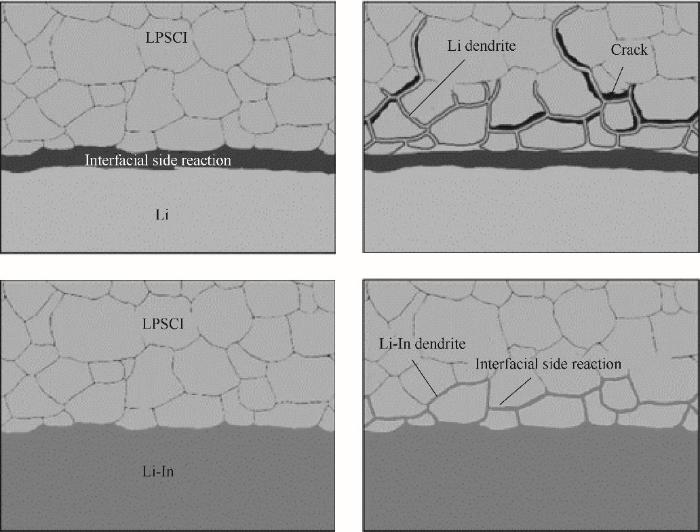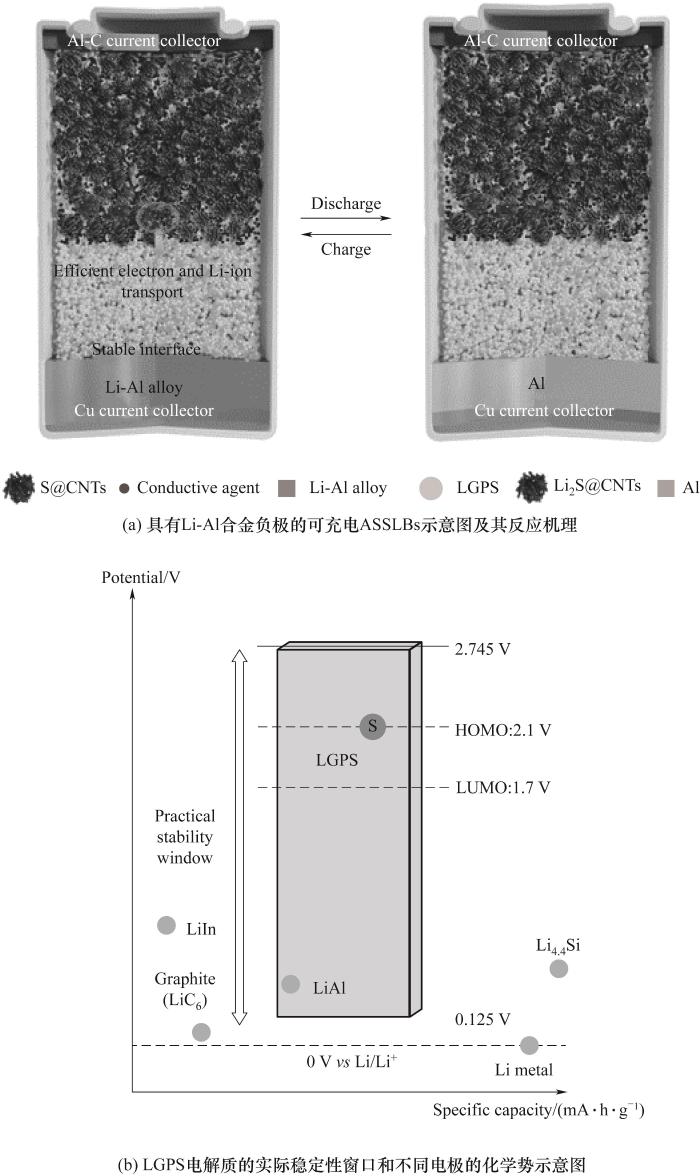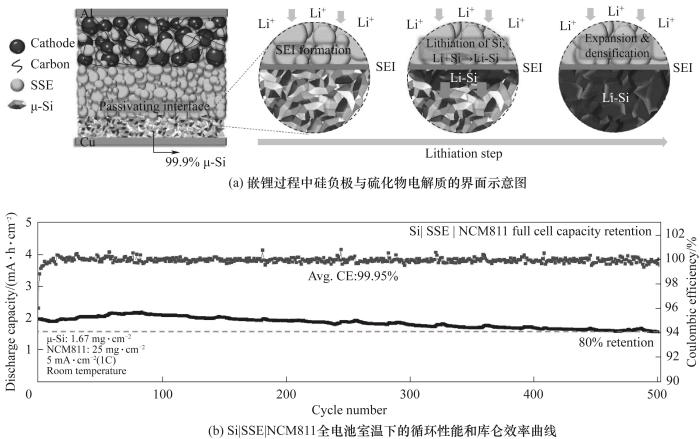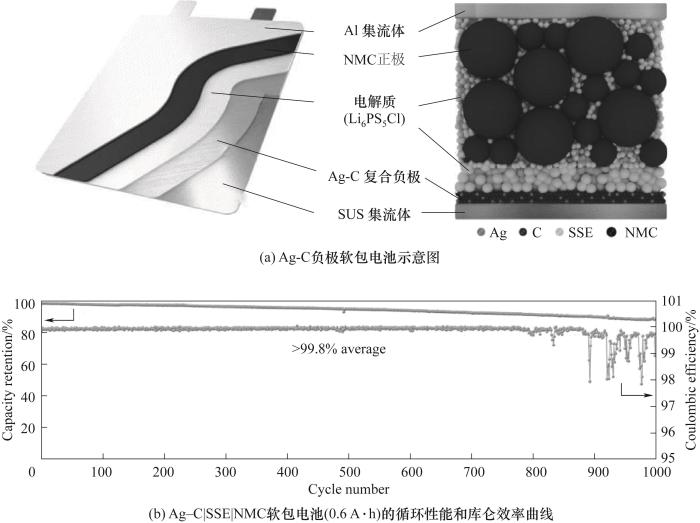Continuing from the previous article
Recent progress on anode for sulfide-based all-solid-state lithium batteries
—— Part 2 other anodes
Author: JIA Linan, DU Yibo, GUO Bangjun, ZHANG Xi
1. School of Mechanical Engineering, Shanghai Jiao Tong University, Shanghai 200241, China
2. Shanghai Yili New Energy Technology Co. , LTD. , Shanghai 201306, China
Lithium alloy anode
Due to severe interfacial side reactions, pure lithium is difficult to be directly used in sulfide solid electrolytes in the short term, so lithium alloy materials provide a more attractive option. Compared with metallic lithium anodes, lithium alloy anodes can improve interface wettability, inhibit the occurrence of interface side reactions, enhance the chemical and mechanical stability of the solid electrolyte interface, and avoid short circuits caused by the growth of lithium dendrites. At the same time, compared with liquid lithium-ion batteries, alloy anodes can show higher energy density and better stability in all-solid-state batteries. However, alloy negative electrodes will undergo larger volume and structural changes during charge and discharge (such as Li-Si alloy, Li-Sn alloy, etc.), so further research is needed on the development and application of alloy materials. Among various lithium alloys, Li-In alloy is popular at the laboratory scale due to its better mechanical ductility and constant redox potential (0.62 V vs Li+/Li) over a wide stoichiometric range. Li-In alloys are generally considered to be thermodynamically and kinetically stable materials for sulfide electrolytes. It is widely used in laboratories to test the performance of electrolytes or cathode materials, while showing good cycle stability under low current and low load conditions. However, the redox potential and molecular weight of Li-In alloy are high, which greatly reduces the energy density advantage of all-solid-state lithium-ion batteries. Generally, studies believe that there is no growth of lithium dendrites in Li-In alloys. However, Luo et al. conducted charge and discharge tests on Li-In|LPSCl|LNO@NCM622 all-solid-state battery under high current density (3.8 mA·cm-2) and high load (4 mA·h·cm-2). The battery was found to have a short circuit after approximately 900 cycles. The battery maintained stable cycle capacity and nearly 100% Coulombic efficiency during charge-discharge cycles up to 890 cycles, but the capacity began to decline rapidly after 891 cycles, falling to near 0 at the 897th cycle. The relevant charge and discharge voltage curve of the battery from the 891st to the 897th cycle, in which the charging capacity gradually increases, while the corresponding discharge capacity decreases. In the 897th cycle, the battery continues to charge and the capacity continues to increase, accompanied by a lower voltage increase rate, which indicates the occurrence of an internal short circuit and battery failure. The growth mechanism of Li-In dendrites was revealed through SEM, XPS and other characterizations and AIMD simulation. Indicates that under high current and high load conditions. Metallic In is thermodynamically and kinetically unstable to sulfide electrolytes. Volume changes and slight interfacial reactions induce the growth of Li-In dendrites, ultimately leading to battery failure during long cycles. Different from the vertical growth of lithium dendrites, the growth mode of Li-In dendrites is lateral growth along the pores and grain boundaries. The growth rate is slow and it causes little damage to the sulfide electrolyte structure (Figure 6). Therefore, Li-In dendrite growth can be suppressed by improving the electrochemical stability of the metal electrode/solid electrolyte and reducing the porosity of the electrolyte.

Fig.6 Before and after cycling interface evolution for Li-In|LPSCl|LNO@NCM622 cell
Al has the advantages of high ductility, high reserves, and high electronic conductivity. It has a high theoretical specific capacity (990 mA·h·g-1) and a small volume expansion rate (96%) among lithium alloy materials. It is one of the more promising all-solid-state lithium battery anode materials. As shown in Figure 7(a), Pan et al. prepared a Li-Al alloy negative electrode without binder and conductive agent (Li0.8Al, specific capacity 793 mA·h·g-1, 0.35 V vs Li+/Li). Has good compatibility with LGPS electrolyte. This is due to the fact that the working potential of the prepared Li-Al alloy anode is within the actual electrochemical stability window of LGPS [Fig. 7(b)]. Preventing the electrolyte from being reduced and decomposed, the assembled all-solid-state battery showed excellent reversibility, with a capacity retention rate as high as 93.29% in 200 cycles. Under the condition of N/P ratio of 1.25, the battery energy density reached 541 W·h·kg-1, proving that Li-Al alloy has excellent application prospects.

Fig.7 Schematics of the Li-Al alloy anode in ASSLBs
Sakuma et al. studied the matching of Li-Sn alloy, Li-Si alloy and Li4-x Ge1-x P x S4 electrolyte, and observed smaller interface resistance and higher redox potential. Hashimoto et al. used high-energy ball milling to prepare a series of Li4.4Ge x Si1-x (x=0~1.0). Among them, Li4.4Ge0.67Si0.33 shows the largest specific capacity (190 mA·h·g-1) and has good charge and discharge reversibility. Park et al. used mechanical ball milling to mix and grind lithium powder and silicon powder to prepare the Li4.4Si alloy, Li4Ti5O12 positive electrode, and Li2S-P2S5 electrolyte to assemble an all-solid-state lithium battery. The study found that the performance of the battery was significantly improved after secondary ball milling of the Li-Si alloy, that is, the reduction in the particle size of the lithium-Si alloy was conducive to the uniform deposition and stripping of lithium during the charge and discharge process.
Lithium alloy films can also be used as a means to stabilize the negative electrode interface. Choi et al. used a simple rolling method to combine Ag with a thickness of 10 μm and Li with a thickness of 150 μm and then externally applied pressure to obtain a Li-Ag alloy film. The high content of Ag easily forms a stable interface with the sulfide electrolyte and inhibits the growth of lithium dendrites. In addition, the remaining small amount of Ag that does not form the Li-Ag alloy participates in the solid solution reaction with Li, which alleviates the uneven growth of lithium. The assembled all-solid-state battery showed a capacity retention of 94.3% over 140 cycles, and could also cycle stably at a high rate of 12 C. Research by Kato et al. found that inserting an Au film at the Li/Li3PS4 electrolyte interface can prevent the formation of voids after initial lithium dissolution and increase Li deposition sites, which helps improve the reversibility of the battery. In addition, the dissolution of the Au film into metallic lithium may be a reason for improving the electrochemical performance of the negative electrode interface. Li-symmetric cells with an Au film inserted at the Li/Li3PS4 interface can operate stably at high current density (1.3 mA·cm-2) and large-area capacity (6.5 mA·h·cm-2) without short circuit. The assembled Li/Au/Li3PS4/LiNi1/3Mn1/3Co1/3O2 all-solid-state battery has a cycle life of more than 200 times at a high current density of 2.4 mA·cm-2.
Silicon anode
Si is considered to be one of the most promising anode materials due to its ultra-high theoretical specific capacity (4200 mA·h·g-1), high reserves, low cost, environmental friendliness, non-toxicity, and low operating potential of 0.4 V. Research on the application of Si anodes in liquid lithium-ion batteries has been developed for more than thirty years and is still very popular. Recently, as all-solid-state lithium batteries have entered the field of energy research, work has begun to convert the well-developed silicon technology from liquid lithium-ion battery systems to all-solid-state battery systems. However, compared with the research on developing high-capacity silicon anodes for liquid lithium-ion batteries, although there are few reports on the application of silicon anodes based on sulfide all-solid-state batteries, the results demonstrated are still quite important. However, the Si anode has low electronic conductivity (1.56×10-3 S·m-1), low lithium ion diffusion coefficient (10-14~10-13 cm2·S-1), and large volume expansion (Li4. 4Si is about 360%) and other disadvantages, which limits its application scope. The reason why the Si negative electrode fails in the battery is generally due to the large volume expansion of Si during the lithiation/delithiation process, which causes powdering, cracking and huge stress, and produces a series of serious destructive consequences. For example: (1) Deterioration of the structural integrity of the electrode due to repeated crushing during discharge/charge. (2) Disconnection between the electrode and current collector caused by interfacial stress. (3) Lithium ions are continuously consumed during the continuous formation-destruction-reformation process of the SEI layer.
Currently, commonly used methods for optimizing silicon anodes for all-solid-state lithium batteries include size control (nano-silicon), structural design, thin film anodes, alloying, pressure application, composite anodes with advanced binders/conductive materials (such as Si-C anodes), etc. Sakabe et al. used magnetron sputtering to prepare non-porous and porous amorphous silicon anodes, and combined them with 80Li2S·20P2S5 electrolyte to conduct cycle capability tests. After 100 cycles, the 3.00 µm-thick nonporous amorphous silicon film only showed about 47% capacity relative to the 10th cycle. The 4.73 µm porous amorphous silicon film shows a lithiation capacity as high as 3000 mA·h·g-1. After 100 cycles, the capacity retention rate compared to the 10th cycle exceeds 93%. It shows that the porous structure can effectively improve the cycle stability of the battery. Okuno et al. applied the porous silicon composite anode to an all-solid-state battery with Li3PS4 electrolyte and showed a high capacity retention rate of more than 90% in 100 cycles. This is because the pores in the silicon particles resolve the huge volume changes during lithiation and delithiation, improving cycle stability. In contrast, the cycle stability of commercial non-porous silicon anodes is poor, and the capacity retention rate in 100 cycles is only 20% or even lower. Poetke et al. reported that silicon-carbon composite void nanomaterials were used as negative electrodes for all-solid-state lithium-ion batteries and were successfully applied to Si-C|Li6PS5Cl|NCM full batteries. The nanostructured Si-C composite used in the study provides a gap between silicon nanoparticles (SiNPs) and an outer carbon shell. The carbon shell can effectively compensate for silicon volume changes, improving electrochemical performance compared with bare SiNPs.
In recent years, the academic community has repeatedly achieved breakthroughs in the research of pure silicon anodes. In 2020, Cangaz et al. reported a columnar silicon anode prepared by a PVD process, and combined with a Li6PS5Cl electrolyte and a LiNi0.9Co0.05Mn0.05O2 cathode to prepare an all-solid-state battery with a high specific capacity (210 mA·h·g-1). The columnar silicon anode has been stably cycled for more than 100 times under a high load of 3.5 mA·h·cm-2, with a Coulombic efficiency as high as 99.7%~99.9%. During the cycle, the columnar silicon structure exhibits a one-dimensional breathing effect similar to the lithium anode in the vertical direction. This one-dimensional breathing can be compensated by the intrinsic porosity of the columnar silicon structure and the external stack pressure, forming a stable two-dimensional SEI. At the same time, the stack pressure (20 MPa) also suppresses the delamination of the columnar silicon and the current collector. Compared with metallic lithium anodes, this columnar silicon anode eliminates the risk of lithium dendrites, short circuits and dead lithium loss. In 2021, Tan et al. reported a 99.9.9% (mass) commercial micron-grade pure silicon Si (μ-Si) anode. The interface contact area between the negative electrode and the Li6PS5Cl electrolyte is a two-dimensional plane, even if volume expansion occurs during charge and discharge. However, the two-dimensional plane is still retained, and no new interface is formed. The Li-Si alloy formed by the lithiated μ-Si negative electrode has unique chemical and mechanical properties, which increases the contact area between the negative electrode and the electrolyte [Figure 8(a)]. The all-solid-state lithium battery assembled by μ-Si, Li6PS5Cl electrolyte and NCM811 can operate stably within a high surface current density (5 mA·cm-2) and a wide temperature range (-20~80℃). It has a capacity retention rate of 80% after 500 stable cycles and an average Coulombic efficiency of 99.95% [Figure 8(b)], which is the best performance of micro-silicon all-solid-state batteries reported so far. It is worth mentioning that the μ-Si anode undergoes high current density cycling without conductive carbon materials, effectively suppressing the decomposition of the sulfide electrolyte. It provides new ideas for the adverse effects of carbon in Si-C composite electrodes in conventional thinking. In 2022, Cao et al. prepared a composite negative electrode composed of nano-silicon (nm-Si) particles, conductive carbon, and Li6PS5Cl through ball milling. The composite negative electrode has good electronic and ion conductivity inside, which can effectively reduce the local current density and inhibit the generation of lithium dendrites on the surface of the negative electrode. It is combined with a single crystal NMC811 cathode material coated by a sol-gel method. Using a Li6PS5Cl film with a thickness of 47 μm as the electrolyte, an all-solid-state lithium battery with an energy density of up to 285 W·h·kg-1 was obtained. The full battery achieved a high capacity of 145 mA·h·g-1 at C/3 for 1000 stable cycles. The composite silicon anode shows the prospect of large-scale manufacturing, significantly reduces costs, and provides a direction for the commercialization of all-solid-state lithium batteries. Different from Tan's negative electrode design concept, this composite negative electrode not only adds electrolyte but also adds carbon conductive agent. The reason is that compared with μ-Si, nm-Si has a higher surface area, there are more boundaries in the silicon anode, and there is usually a layer of SiO on the surface of nm-Si. Therefore, the electrical conductivity is generally 3 orders of magnitude lower than that of μ-Si, which hinders electron conduction during charge and discharge. Experiments show that during the process of removing lithium from this nm-Si anode, the electrolyte only decomposes slightly, and no lithium dendrites are produced. Based on the above system, Cao et al. proposed a battery architecture with a bipolar stack design. The single cells are connected in series through a current collector to reduce the use of inactive materials, thereby achieving higher energy density. More specifically, a double-layer stacked all-solid-state lithium battery made of interface-stable single crystals LiNi0.8Mn0.1Co0.1O2, Li6PS5Cl, and nm-Si serve as the positive electrode, electrolyte, and negative electrode respectively, providing a high voltage of 8.2 V. The battery-level energy density is 204 W·h·kg-1, which is higher than the 189 W·h·kg-1 of a single battery. This bipolar stacked design has good reference significance for the entire all-solid-state battery field.

Fig.8 Interfacial characterization and cycling performance between µ-Si anode and Li6PS5Cl in the ASSLBs
Table 1 summarizes the solutions to the sulfide solid electrolyte/anode interface and the corresponding advantages and disadvantages.
Table 1 Addressing strategies of interfacial issues between anodes and sulfide-based solid-state electrolytes
|
Type of anode |
Improvement strategy |
Advantage |
Disadvantages |
|
Lithium metal |
Apply external pressure |
Increase the solid-solid contact area of the negative electrode/electrolyte to facilitate the transmission of lithium ions. |
Unable to solve the stability problem of the negative electrode interface |
|
artificial SEI film |
It avoids direct contact between lithium metal and sulfide solid electrolyte, effectively inhibits side reactions, improves the stability of the negative electrode interface, and increases the cycle life of the battery. |
Artificial SEI will continue to be consumed as the battery cycles, and will eventually lead to direct contact between lithium metal and sulfide electrolyte, affecting the service life of the battery. |
|
|
Electrolyte optimization |
Inhibit the occurrence of interface side reactions |
Long-term battery cycling will still produce interface side reactions and the formation of lithium dendrites. |
|
|
Modification of lithium anode |
Avoid direct contact between lithium metal and sulfide electrolyte to inhibit side reactions and the generation of lithium dendrites |
A single negative electrode modification cannot inhibit the formation of lithium dendrites, and the structure and composition of the electrolyte need to be optimized. |
|
|
Alloy anode |
Replace lithium metal with lithium alloys, such as Li-In, Li-Al, Li-Sn, Li-Si alloys, etc. |
Lithium alloy anodes can improve interface wettability, inhibit the occurrence of interface side reactions, enhance the chemical and mechanical stability of the solid electrolyte interface, and avoid short circuits caused by the growth of lithium dendrites. |
In Li-M alloys, when M is a metal, the redox potential and molecular weight of the metal are relatively high, which greatly reduces the energy density advantage of solid-state batteries. Li-Si alloy does not have good data support yet |
|
Silicon anode |
Replace lithium metal with silicon-containing negative electrodes, such as Si-C, nm-Si,μ-Si negative electrodes, etc. |
Silicon-containing anodes have ultra-high theoretical specific capacity and low working potential. Multiple studies have shown that silicon anodes and sulfide electrolytes have good interface stability, making them an excellent anode choice for all-solid-state lithium batteries. |
The cost of nm-Si anode is relatively high, which limits large-scale production and application. |
Other anodes
Silver carbon negative electrode
Lee et al. reported an all-solid-state battery design using a silver-carbon (Ag/C) interlayer [Figure 9(a)]. This interlayer design effectively regulates the lithium deposition process, and highly reversible lithium deposition and stripping phenomena are observed between the Ag/C layer and the current collector. Among them, C is used to separate the Li6PS5Cl electrolyte from the deposited metallic lithium, which not only avoids the reduction of the electrolyte but also prevents the generation of lithium dendrites. Ag can reduce the nucleation energy of metallic lithium to form an Ag-Li alloy. Part of the Ag moves to the surface of the current collector to form a solid solution with metallic lithium, promoting uniform lithium deposition. After the discharge, the metallic lithium layer is completely dissolved, while Ag remains between the current collector and the Ag-C layer. This design can accommodate the volume change of metallic lithium during cycling, reduce the local current density of the lithium anode, and improve cycle stability. As shown in Figure 9(b), the assembled pouch battery (0.6 A·h) exhibits high energy density (greater than 900 W·h·L-1) at 60°C. Stable Coulombic efficiency exceeding 99.8%. Long cycle life (1000 cycles). It provides new ideas for the commercial application of all-solid-state lithium batteries.

Fig.9 Structure and cycling performance for sulfide-based ASSLBs used Ag-C anode
Graphite
Among various intercalated anode materials for lithium-ion batteries, graphite is the most commercially successful material due to its low cost, large reserves, and long cycle life. However, in the field of all-solid-state batteries, graphite has not become the focus of negative electrode material selection due to its limited theoretical capacity. In early reports, graphite was often used as the anode material for newly synthesized sulfide solid electrolytes. Later research turned to focus on the basic working mechanism of graphite in sulfide ASSLBs to optimize the design and manufacturing of electrodes. Graphite is often used as a framework for high-energy anode materials in recent research, providing structural integrity and electrical conductivity. However, other current negative electrodes such as lithium and silicon still have problems such as high cost, large volume expansion rate, and unstable cycle. Therefore, graphite, as a material with low cost, large reserves, high degree of commercialization and high stability, can play an important role in the process development of all-solid-state batteries in the early stages. It is necessary to continuously optimize the available capacity of graphite.
Current collector pretreatment
Anodeless lithium-ion batteries assemble the current collector directly with the battery without adding excess lithium, where metallic lithium is formed by the reduction of lithium ions on the current collector from the fully lithiated cathode plating during the first charge cycle. This concept has been studied extensively in the field of lithium-ion batteries, and some teams have extended this design to all-solid-state lithium batteries. Gu et al. etched the surface of stainless steel current collector (SSCC) to varying degrees, matched it with Li5.5PS4.5Cl1.5 solid electrolyte, and conducted electrostatic cycling using an asymmetric battery configuration (lithium foil | stainless steel foil). Experimental results show that different SSCC roughnesses have a greater impact on battery performance. All-solid-state batteries assembled with SSCCs with a roughness of 180 nm have better electrochemical cycle performance than batteries with a roughness of only 20 nm. This is due to the rough surface increasing the contact points between the electrolyte and the current collector, providing multiple reaction points and allowing uniform deposition of lithium on the interface. However, when the surface roughness exceeds 500 nm, the highly roughened surface causes the lithium ions to barely reach the limited contact points at the etched bottom of the current collector. This reduces the precipitation of lithium and shows worse performance. This phenomenon does not occur in liquid batteries. This shows that the interaction between the solid electrolyte and the current collector is significantly different from that of the liquid electrolyte. It is necessary to further explore the basic working mechanism and characteristics before the current collector design of the negative electrode-free all-solid-state battery can be carried out.
Summary and Outlook
With the emergence of LGPS with high ionic conductivity, research on sulfide all-solid-state lithium-ion batteries has greatly increased. Among them, the selection of anode materials and the solution of interface problems have become one of the focuses of research. Many scholars have comprehensively summarized the research progress on the lithium anode/sulfide electrolyte interface. This article provides a systematic overview of the mainstream anode materials for all-solid-state lithium batteries based on sulfide electrolytes, such as metallic lithium, lithium alloys, and silicon anodes. The interface problem between lithium anode and sulfide electrolyte was proposed, and common strategies to improve the interface properties were summarized. At present, all-solid-state lithium-ion batteries are still far from commercial application and lack complete basic theoretical research and technical support. Therefore, the following issues still need to be paid attention to in future research.
(1) Lithium alloy anodes have excellent lithium storage capacity and more stable performance, and have shown great potential in solving lithium anode dendrite growth and short circuit, achieving high energy density and long-term stable all-solid-state lithium batteries. In the field of all-solid-state batteries, due to the contact characteristics of the solid-solid interface, the problem of repeated SEI generation caused by the reaction of alloy materials and liquid electrolytes can be solved. In order to better apply alloy anodes, basic and applied work needs to be carried out to increase the understanding of the chemistry, electrochemistry, mechanical properties and working mechanism of alloy anodes in solid-state batteries, so as to meet the demand for high-capacity, long-term stable solid-state batteries. .
(2) Silicon anodes can maximize the energy density of all-solid-state lithium-ion batteries. However, because silicon has low electronic conductivity, commonly used carbon conductive agents will accelerate the decomposition of sulfide electrolytes. How to regulate the composition parameters of the silicon anode so that it neither affects the conductive path of the electrode nor causes the decomposition of the sulfide electrolyte is a major challenge facing the silicon anode preparation process. It is also a technical barrier for large-scale industrialization of silicon anodes in sulfide solid-state batteries.
(3) The problems of small reserves and high price of metallic lithium also need to be paid attention to in actual commercial applications. Although the metallic lithium anode is beneficial to the lithium plating process, it is not a necessary component to achieve electrochemical reaction lithium plating. The usage conditions of lithium metal are extremely harsh, and the mass production of lithium batteries will bring huge safety risks. Therefore, in order to reduce costs, improve safety and achieve ultimate commercialization, the development of all-solid-state lithium batteries without lithium anodes is a research direction. For example, the research on Ag-C composite electrode provides a good idea for the next work. In addition, the basic working mechanism and characteristics of current collectors also need further research to pretreat current collectors in a targeted manner to obtain high-performance all-solid-state batteries without negative electrodes.
The development of negative electrode materials in the field of all-solid-state batteries still has a long way to go. With the deepening of research, all-solid-state batteries based on high-energy negative electrodes will definitely show their unique advantages in the field of secondary batteries.